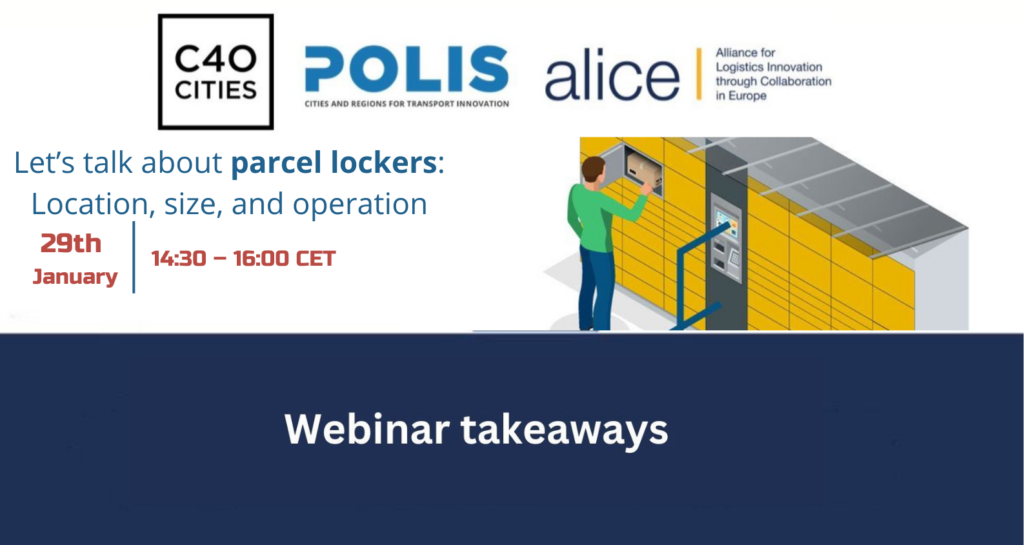Thursday, February 6th, 2025
On 29 January 2025, ALICE, C40 Cities, and POLIS hosted a webinar focused on the role of parcel lockers in improving urban logistics and last-mile deliveries. The session featured insights from experts and city representatives from Europe and North America (New York City, Valence, London, Stockholm, and Groningen), who discussed best practices, challenges, and strategies for scaling up parcel locker networks. Below are the key takeaways from the event.
The role of parcel lockers in urban logistics
Parcel lockers are increasingly recognised as a critical last-mile delivery solution in urban and suburban environments. They help cities and businesses address key logistics challenges, including:

Best practices and key takeaways
Lessons from cities
New York City’s LockerNYC pilot programme, launched in 2021 as part of the city’s freight plan, aims to improve last-mile logistics. Stephen Solecki, Acting Deputy Director, NYC Freight Mobility Unit, presented on its progress.
The programme has 15+ locker sites, 1,200+ users and 7,000+ transactions, with a 30% increase in usage. Key challenges include 90,000+ lost packages per day, 90% of deliveries dependent on trucks, and limited sidewalk space and power access.
Next steps focus on expanding lockers, reducing emissions and integrating cargo bikes. Strategic location is critical to success.
France: Master plan for out-of-home deliveries in Valence
Martin Munier-Jolain, Transport Engineer, Interface Transport, presented how the Valence Romans Mobilites developed a master plan to improve the efficiency of parcel collection. With 0.7 collection points per 1,000 inhabitants, most are located in local shops, while dedicated lockers remain limited. 72% of users drive to collection points, especially in rural areas, and shopkeepers struggle with parcel management, increasing the demand for lockers.
To improve efficiency, the plan recommends locating lockers in high-traffic areas such as train stations, prioritising multi-operator lockers and integrating lockers into urban development projects. Strategic placement along commuter routes is key to minimising unnecessary car journeys.
London: Parcel lockers: CRP projects & experiences
Isidora Rivera Vollmer, Project Manager, Cross River Partnership (CRP), looked at London’s experience. The city is testing parcel lockers as part of urban logistics initiatives that include cargo bikes delivery. The Chelsea Harbour Sustainable Delivery Hub features parcel lockers and cargo bike bays, with future plans to integrate river freight for multimodal last-mile delivery. The South Dock Marina Parcel Locker helps reduce congestion and provides 24/7 access for boaters.
Challenges include slow council approval processes, while battery-powered lockers provide a cost-effective, flexible solution. Integrating lockers with sustainable transport improves efficiency and reduces emissions.
Stockholm: From pilot to policy
Victoria Herslöf, Transport Department, City of Stockholm, explained that Stockholm launched a two-year pilot to test parcel lockers in 2020 and later established a permitting process for installations of parcel lockers on public land to help reduce overlapping functions of the existing pick-up-drop-off network. The evaluation emphasised pedestrian-friendly locations, security and carrier-agnostic lockers to improve accessibility and reduce duplication.
Groningen: Data-driven locker extension
Remy Baas, Policy Advisor for Urban Logistics, City of Groningen, explained that a new framework for parcel lockers has been recently developed, in collaboration with the University of Groningen and Bax Innovation. He underlined that Groningen is developing a parcel locker policy, with existing lockers already showing high uptake and emission reductions. Plans focus on expanding multi-carrier lockers and optimising locations near transport hubs to promote walkability.
This webinar highlighted how parcel lockers can improve urban logistics by reducing congestion, increasing efficiency and supporting sustainable transport. With strategic placement and collaboration, cities can maximise their impact and create more accessible delivery networks.
